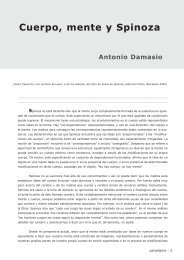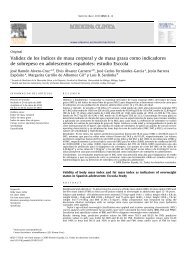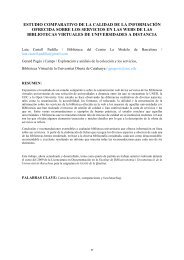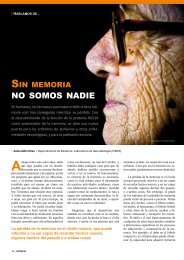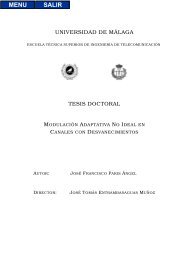Estereotipos negativos hacia la vejez y su relación con variables ...
Estereotipos negativos hacia la vejez y su relación con variables ...
Estereotipos negativos hacia la vejez y su relación con variables ...
Create successful ePaper yourself
Turn your PDF publications into a flip-book with our unique Google optimized e-Paper software.
Referencias<br />
Giammarinaro, C., Himberly, H. y Pollock, J. (1996). The effect of perceived age on the psychological<br />
evaluation of elderly and nonederly depressed and non-depressed clients. Dissertation<br />
Abstracts International: Section-B:- The Sciencies and Engineering, 57(3), 2150-2157.<br />
Gilbert, D. T. y Hixon, J. G. (1991). The trouble of thinking: Activation and aplication of stereotypic<br />
beliefs. Journal of Personality and Social Psychology, 60(4), 509-517.<br />
Giles, H. y Williams, A. (1994) Patronizing the young: Forms and evaluations. International Journal<br />
of Aging and Human Development, 39(1), 33-53.<br />
Gil-Gómez de Liaño, B. y Botel<strong>la</strong>, J. (2003). Diferencias en el efecto priming negativo en <strong>la</strong> edad: un<br />
metaanálisis. Revista Españo<strong>la</strong> de Geriatría y Gerontología, 38(3), 161-169.<br />
Gilman, S. (1986). Jewish self-hatred: Anti-semitism and the hidden <strong>la</strong>nguage of the jews. Baltimore:<br />
Johns Hopkins University Press.<br />
Gill, T. M. y Feinstein, A. R. (1994). A critical appraisal of the quality-of-life mea<strong>su</strong>rements. JAMA,<br />
272 (8), 619-631.<br />
Gillis, M. (1973). Attitudes of nursing personnel toward the aged. Nursing Research, 22, 517-520.<br />
Glenn V., Ostir, B., Kyriatos, S., Markides, P., Sandra, A., B<strong>la</strong>ck, P. D. y James, S. Goodwin, M. D.<br />
(2000). Emotional Well-Being Predics Subsequent Functional Independence and Survival<br />
JAGS 48, 473-478, by the American Geriatrics Society.<br />
Goldsmith, R. E. y Heiens, R. A. (1992). Subjective age: A test of five hypotesis. The Gerontologist,<br />
32, 312- 317.<br />
Golub, S. A., Filipowicz, A. y Langer, E. (2002). Acting your age. En T. Nelson, (Ed) Ageism:<br />
Stereotyping and prejudice against older persons (pp. 277-294). Cambridge, MA,US: The<br />
MIT Press.<br />
Gómez, A., Varona, W., Alonso, M. C., García, L. y Menéndez, J. (1993). Salud percibida, utilización<br />
de servicios y <strong>con</strong><strong>su</strong>mo de medicamentos en una pob<strong>la</strong>ción anciana no institucionalizada.<br />
Atención Primaria, 11, 233-238.<br />
Gómez, G. E., B<strong>la</strong>ttstein, D. O. y Gómez, E. (1985). Beginning nurse students can change attitudes to<br />
the aged. Journal of Gerontological Nursing, 11(1), 6-11.<br />
González, P., B<strong>la</strong>nton, H. y Williams, K. (2002). The effects of stereotype threat and double –minority<br />
status on the test performance of <strong>la</strong>tino women. Personality and Social Psychological Bulletin,<br />
28(5), 659-670.<br />
González, M. y Salgado, A. (1995). La evaluacion de <strong>la</strong> “calidad de vida”: una nueva dimensión de <strong>la</strong><br />
valoración geriátrica integral. Revista Españo<strong>la</strong> de Geriatría y Gerontología, 30(1), 9-15<br />
Gove, W. R., Ortega, S. y Style, C. (1989). The maturational and role perspectives on aging and self<br />
through the adult years: An empirical evaluation. American Journal of Sociology, 94(5), 1117-<br />
1145.<br />
Gracia, M. y Marcó, M. (2000). Efectos psicológicos de <strong>la</strong> actividad física en personas mayores.<br />
Psicothema. 12(2), 285-292<br />
223




